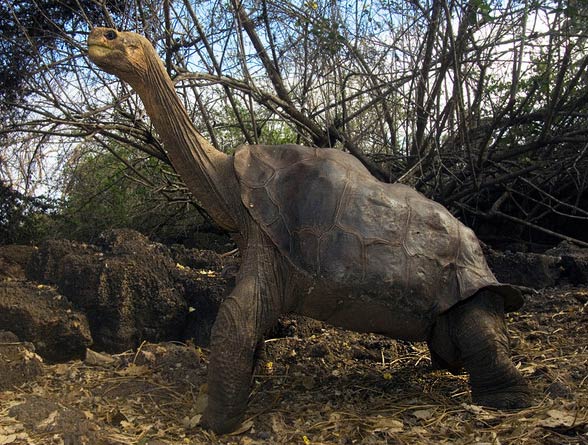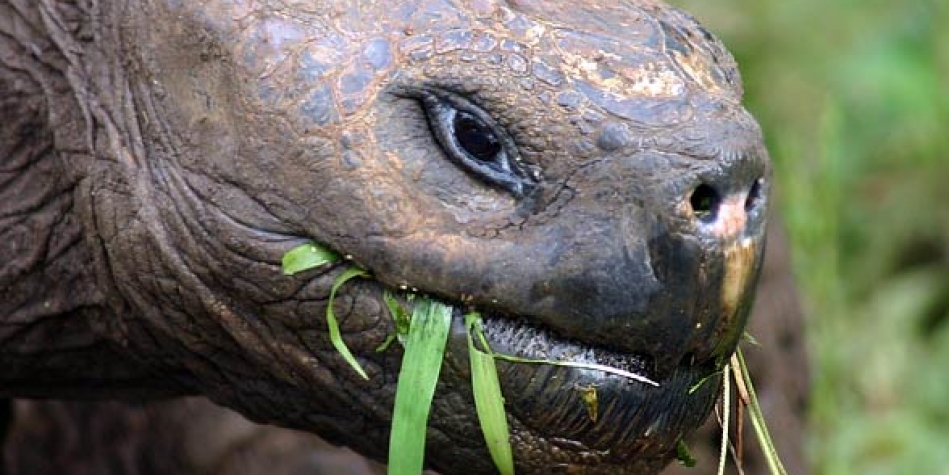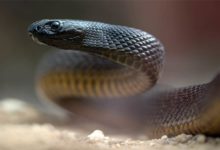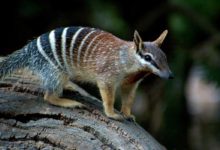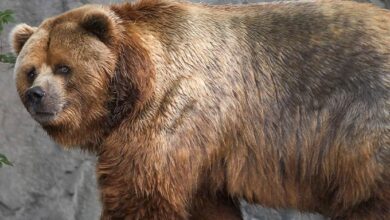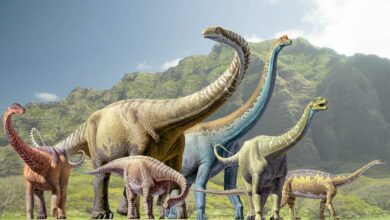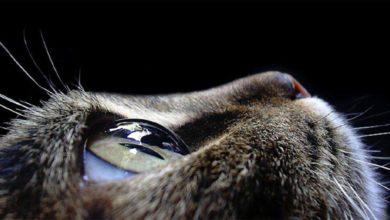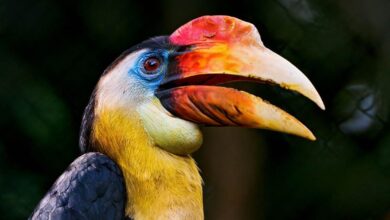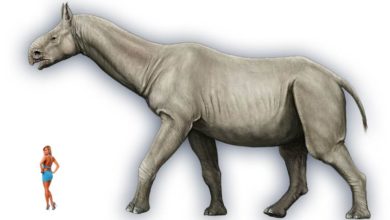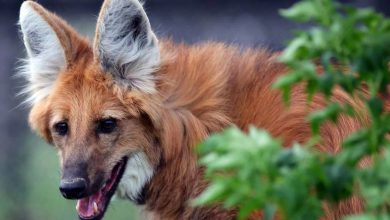Galápagos giant tortoise (Chelonoidis nigra)
A slow pilgrim of the Galapagos Islands. The archipelago was named after these animals (Tortoise Islands), as centuries ago these areas were the realm of giant tortoises. Their calm lives have been interrupted by feral domesticated species, however, that does not change the fact that some of the oldest tortoises may remember Charles Darwin himself…
Classification
- Kingdom: Animalia
- Phylum: Chordata
- Class: Reptilia
- Order: Testudines
- Suborder: Cryptodira
- Family: Testudinidae
- Genus: Chelonoidis
- Species: Chelonoidis nigra
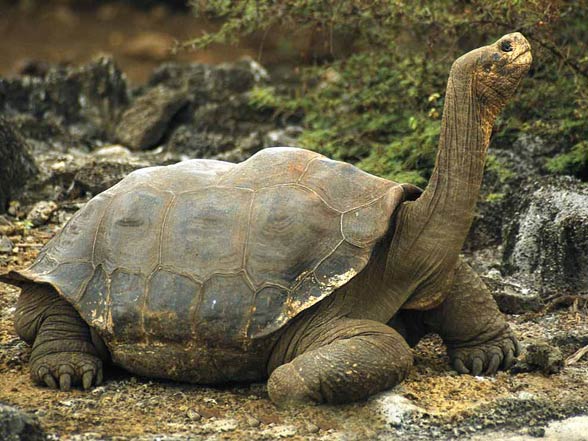
A troublesome classification…
The giant tortoise inhabits seven volcanic islands in the Galapagos archipelago, located about 1000 km west of Ecuador.
… or how many subspecies are there?
Since the 19th century the subspecies classification is a subject of dispute among experts, majority of whom agree with the classification distinguishing 11 subspecies, 10 of which lives in the Santiago, Santa Cruz, San Cristobal, Pinzon, Espanola and Isabela islands, although this number is also controversial, as many naturalists consider it to be too high.
Chelonoidis nigra abingdonii
The Chelonoidis nigra abingdonii subspecies from Pinta Island is considered extinct – the last tortoise of that subspecies called Lonesome George died on 24 June 2012. Although the male copulated with other subspecies females, no tortoise hatched from the eggs.
Floreana Island
The subspecies inhabiting the Floreana Island presumably died out in the middle of 19th century, which is only 15 years after Charles Darwin arrival at the island, who only found an empty carapace.
Zoo tortoises
In zoological gardens, tortoises from various islands are mated together, so a fertile offspring is hatched from mixed subspecies pairs` eggs. Still, ‘multiracial’ tortoises are less fertile and die earlier than offspring of the same subspecies.
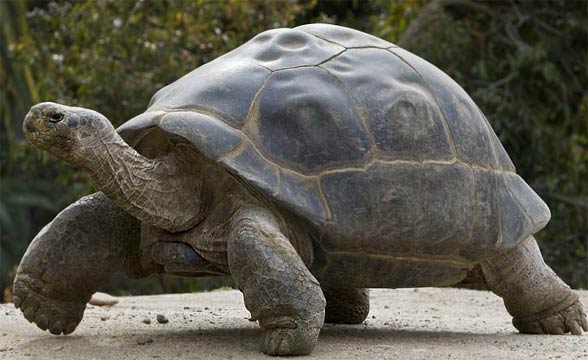
Characteristics
Galapagos giant tortoise carries a mighty, bony, matt brown armor. The plates are connected with ribs by a rigid safety structure being an integral part of the skeleton. The carapaces of those slow-moving animals often have visible growth signs.
The bone plate pattern is preserved as long as the tortoise lives, the annual growth signs vanish, as the outer layer of the carapace rubs with age.
In case of threat, the animal hides its long neck, head, and limbs to the inside of the shell.
Its legs, as its neck, are long and stocky, covered with dry, flaky skin with bony scutes. The front legs have 5 claws, and rear legs have 4.
Due to its enormous size, it is described as one of the largest reptiles in the world, as it is between 1.2-1.8 (3.9-5.9 ft) meters long and weighs on average 270-300 kg (595-661 lbs).
The sexual dimorphism is most visible in populations, which males have more curved carapaces near the neck, saddle-like. All male giant tortoises have a longer tail and a shorter, concave plastron (the flat, ventral part of the carapace).
Moreover the males are larger than females, weigh from 272 to 317 kg (600 to 700 lbs), while the female weigh between 136 and 181 kg (300 and 400 lbs).
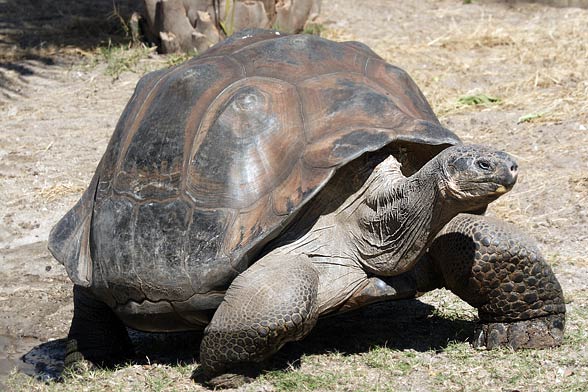
Carapace
Every Galapagos giant tortoise subspecies has a slightly different shape of the shell; they can resemble a saddle, or have a convex, dome-like shape. When the tortoise hides in its shell, there is a bare hole at the neck spot – a proof that in the process of evolution on the island there were no predators threatening reptiles – see Island gigantism.
The islands with a humid climate covered with hills up to 800 meters high (e.g. Santa Cruz) have abundant ground vegetation. The giant tortoise populations from that area have convex carapaces, larger than others have, but also shorter necks and limbs. The tortoises from small islands that are lower than 500 meters (1,640 ft) above sea level and a dry climate (Espanola, Pinzon), determining limited food supply, have mostly the distinctive ‘saddles’.

Size as an adaptive element
The discoverer of Galapagos – Tomas de Berlanga, the bishop of Panama – wrote in 1535: ‘such big tortoises that each could carry a man on top of himself ‘.
The naturalist Charles Darwin arrived at Galapagos in 1835 and noticed: ‘These animals grow to an immense size… several so large that it required six or eight men to lift them from the ground ‘.
As time went by it was established that their size was a rather indispensable adaptive element of living on the islands rather than an effect of island gigantism.
Large animals have better odds of surviving water passages – a long neck assures the head remains over the water surface, and the body volume to area ratio diminishes the water loss through osmosis.
Large reserves of fat and water allow to survive long ocean journeys without food or fresh water supply. The Galapagos tortoise is well adapted to an island climate with a tendency to periods of drought. Large size allows to tolerate extreme temperatures as a result of gigantothermy.
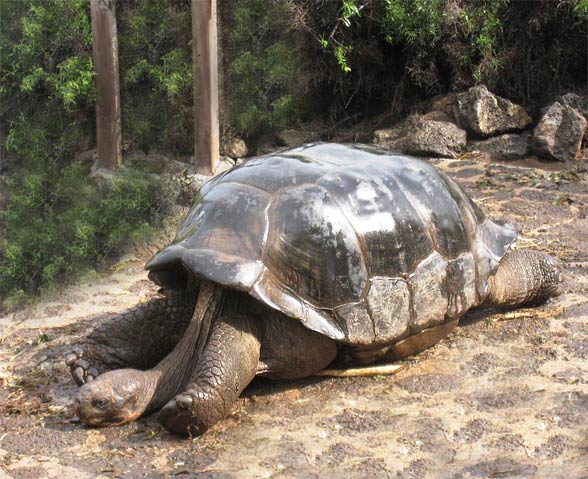
Senses and mutualism
Senses
Charles Darwin wrote in its journals that the aboriginal people of the Galapagos Islands considered the tortoises to be completely deaf, however, his observation defied such an opinion.
Despite being able to hear, tortoises base more on sight and smell.
Mutualism
Mutualism is the mutual interaction between populations or species that brings profit to both sides to such an extent, that the relation is vital for both population`s existence.
The Galapagos tortoise maintains mutual relations with some species of Darwin’s finches (Geospizinae). Small groups of these birds jump on the ground in front of the tortoise. Upon a given signal, the reptile lifts its head and spreads the legs to allow the finches to reach the spots between the carapace and the fleshy body, where many parasites live – a finches` delight.
This cooperation leaves the reptile healthy and the birds full.
The dark side…
The abovementioned mutualism has also its dark side – sometimes the tortoise invites the bird under the carapace allegedly to clean the skin from parasites. When the bird flies into the shell, the tortoise hides its limbs, crushing the bird inside. As it seems, the calm animal sometimes has to restore its protein reserves…
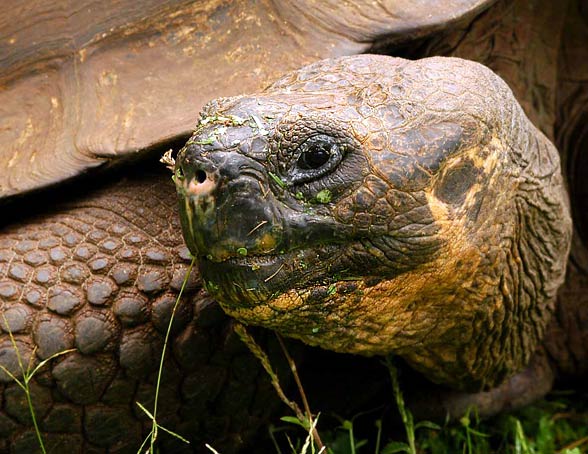
Diet
The Galapagos tortoise is a herbivore, which mainly eats cacti, grass, lichens and fruit. It may eat the fruit of the manchineel trees – one of the most powerful toxins in the world (the tree`s fruit are called ‘poisoned apples’ for a reason…).
Moreover, it eats an endemic guava species, Azolla genus floating ferns and Tillandsia plants.
One tortoise usually consumes 32-36 kg (70-79 lbs) of food a day, digesting it as proficiently as a horse or rhinoceros.
As it likes to eat opuntia flowers, which are abundant in water, it may survive without water source for a long time.
On dry islands it licks the morning dew off the rocks. As a result over the years, tortoises created many semicircular grooves in the rocks – almost like Shaolin monks, although for different reasons…
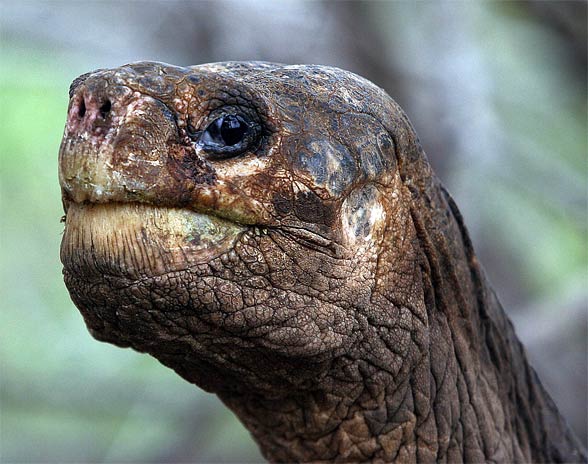
Lifestyle
As a typical reptile, it is a cold-blooded animal, which means that it catches sun rays for 1 – 2 hours in the morning to convert heat into energy and be able to acquire food for the next 8 – 9 hours. It moves very slowly, with a ‘hair-raising’ speed of 0.3 km/h (0.18 mph).
On larger and more humid islands the tortoises migrate seasonally between low hills, which become hilly plains in the rain season, and the areas located higher, about 610 m (2001 ft) high. The migrations take place in the dry season.

Tortoise highways
The same traveling paths are used by whole generations, creating the perfectly evened ducts called the tortoise highways.
On islands with a humid climate, the tortoises with more dome-like carapaces often live in large groups, as opposed to the territorial loners with saddle-like shells.
The giant tortoises rest in mud or swims in the seasonal rain pools, which help in thermoregulation and protect them from parasites such as ticks and mosquitoes.
It sleeps under the rocky shelves, in ground pits or in the water.
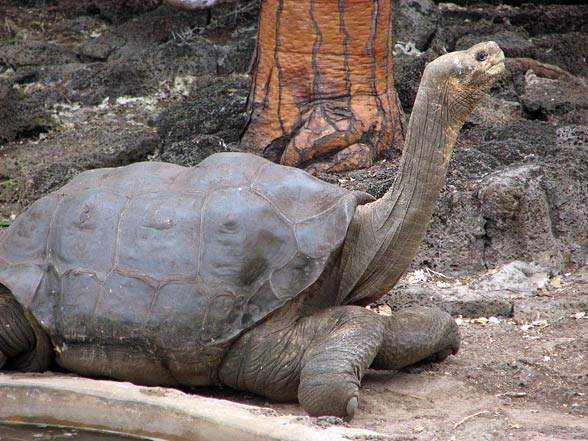
Breeding
Giant tortoises copulate every season of the year, although a breeding peak occurs between February and June, especially on the humid highlands in the rain season.
If the older males meet in this season, they will show dominant behaviors – spreading their necks, opening their mouths and lifting themselves as high as possible on their legs.
Mating fights
From time to time they bite each other`s heads, which is followed by the withdrawal of the shorter tortoise – the size does matter in that matter 🙂
During male fights, the ‘saddled’ animals prove to be the most aggressive, they bite more often.
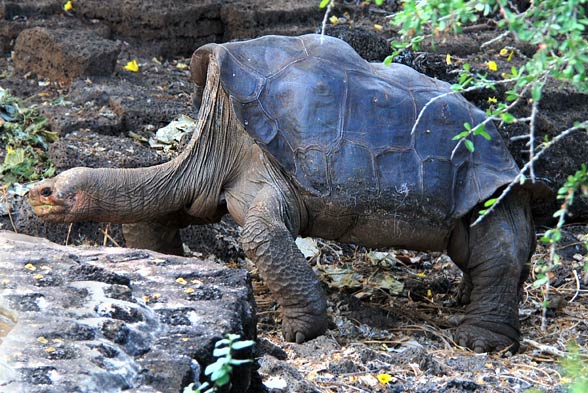
Mating vocalizations (sounds)
In the mating season males murmurs with a hoarse voice – these vocalizations are called rhythmic groans. It is one of few vocalizations emitted by this reptile. Other sounds are produced during aggressive behaviors towards other males that resemble hissing.
Foreplay
Foreplay is often also brutal – the male hits the female`s carapace with its head and bites the limbs – no comment on that…
The copulation itself is very uncomfortable, as the male must try very hard to maintain balance in the unusual position. It is aided by the concave plastron (ventral part of the carapace), allowing to fit over the female shell and perform the copulation.
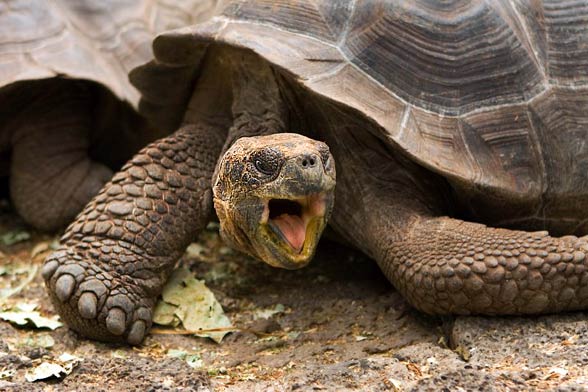
Nests
Between July and November, females go to the nesting spots on the dry, sandy shores. Digging the nest is a very tiresome activity, which takes several hours a day of the future mother`s time (a few days in a row).
A female builds it, digging the rear legs until a cylindrical hole is made, about 30 cm deep. In the nest it lays about 16 spherical and hard eggs, weighing 82-157 g (2.9-5.5 oz) each with the appearance of a billiard ball.
Some observations suggest that the hatches of dome tortoises are larger than saddled ones.
A female creates a hole in the nest, the whole structure being made of dirt mixed with urine. Then it is pressed even with the plastron, which assures the nest is well sealed. In such position, it leaves the future offspring to bask in the sun.
TSD – Temperature Sex Determination
The temperature of incubation influences the gender of baby tortoises – higher temperatures spawn females, while lower spawn mostly males.
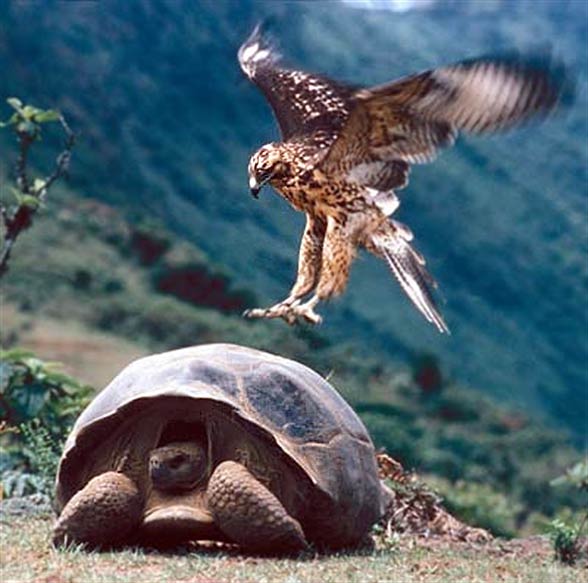
Offspring
After 4-8 months the babies are hatched and they weigh only 50 g (1.7 oz) and are only 6 cm (2.4 in) long. However they are not aided in digging up to the surface, therefore immediately after leaving the egg shell the tortoises must dig for several weeks (nutritional substances from the egg yolk suffice for about 7 months).
In dry condition, the babies often die underground if the soil becomes too dense, while during rain season they often drown.
The babies` subspecies cannot be distinguished on sight as they all have convex carapaces.
For the first 10-15 years they live at the warmer lowland areas; in this period the largest threats are falling rocks and extremely high temperature.
In the past, the only natural enemy these young tortoises had was the Galapagos hawk (Buteo galapagoensis), which was mentioned by Darwin himself. Today this species is very rare and the largest threat for the eggs and babies are feral pigs, dogs, cats, and rats.
In their adult life the Galapagos tortoises have no natural enemies. Darwin noticed that old reptiles rarely die of natural causes – they often fall off cliffs.
The tortoise`s gender may not be distinguished until 15 years of age, while maturity is reached after 20 – 25 years in captivity, or even 40 years in the natural habitat (which is the point of reaching and adult size).
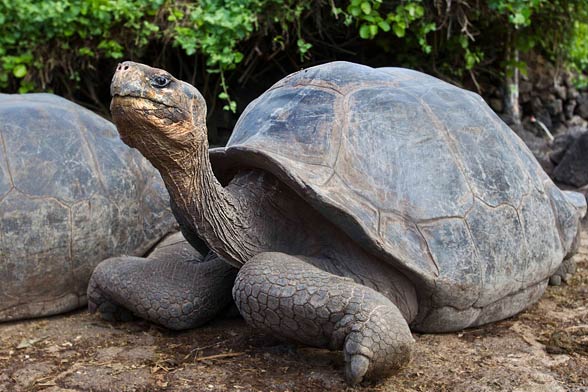
Lifespan
An average lifespan in natural habitat is estimated to be over 100 years, which makes the Galapagos giant tortoise one of the longest living animals in the world.
A tortoise held in captivity, named Harriet, living in an Australian zoo was the oldest known Galapagos giant tortoise being 170 years old (Harriet died in 2006). Experts claim that in 2004 the female was 169 years old, although media stated that it was over 175 years old at the moment of death.
According to some sources Harriet (it was considered a male – Harry – until 1960) could be one of three tortoises brought to London by Charles Darwin.
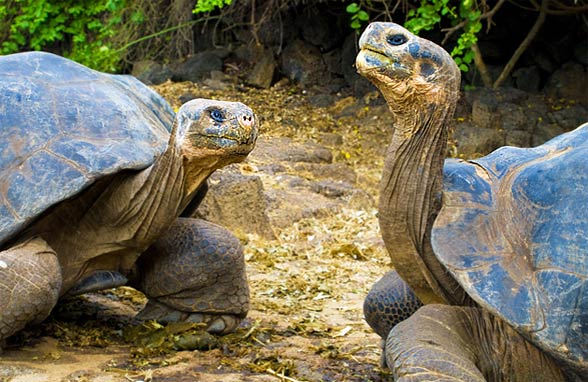
Detailed characteristic / size
Galapagos giant tortoise (Chelonoidis nigra)
- Body length: 1.2-1.8 m (3.9-5.9 ft)
- Weight: males: 272-317 kg (599-699 lbs), record holder over 400 kg (882 lbs); females: 136-181 kg (300-399 lbs)
- Lifespan: over 100 years
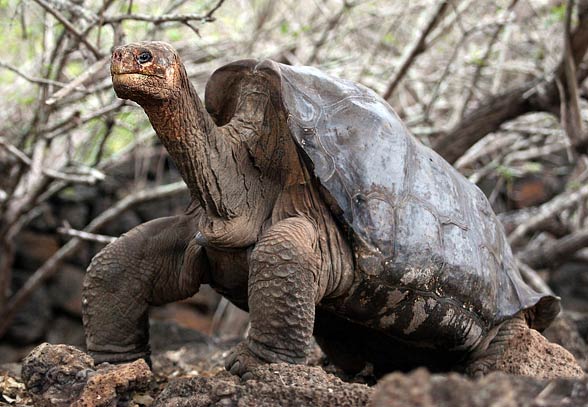
Galapagos giant tortoise – interesting facts
- The name of the islands inhabited by Galapagos tortoises roots in the astonishing numbers of those reptiles at the arrival of Spanish settlers in 16th century. The word Galapago means ‘tortoise’.
- Names of the Galapagos tortoise populations are not accepted by experts – some claim that every subspecies should be reclassified as a separate species.
- Galapagos tortoise is one of the largest living tortoise species (similar in terms of size to Aldabra giant tortoise) and the 13th largest living reptile in the world.
- It may live for 18 months without food or water supply, it eats up the fat reserves, which byproduct is water.
- It sleeps 16 hours a day.
- Galapagos tortoise is an endangered species due to extraneous species of domesticated animals that arrived at the islands with the settlers. Goats are the largest problem as they devour the plants essential for the tortoise’s survival at an extremely fast pace.
- In the past over 250 000 tortoises lived on Galapagos, yet the colonization of the islands caused the number to drop down to about 3000 in the 70s. It is estimated that in the beginning of 21st century about 19 000 tortoises lived in their original habitats, while most of them began their lives in captivity.
